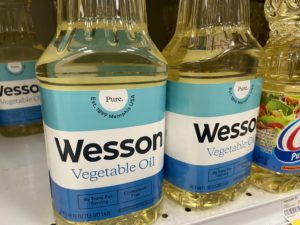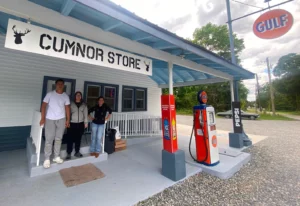OMAHA – ConAgra has consolidated itself into a purveyor of dozens of some of the best-known brands in the United States, including Hunt’s, Swiss Miss, Peter Pan, Blue Bonnet, La Choy, Mueller’s, Jiffy Pop and Banquet. However, if you look at its stock price over the last 20 years, it was only this year that it hit the high it made in 1997.
It should be doing better with these great brands. Let’s list some more, namely Gulden’s, Kid Cuisine, Fiddle Faddle, Wesson, Parkay, Chef Boyardee, Manwich, Pam, Tennessee Pride, Orville Redenbachers, Marie Callender’s, Rotel, Slim Jim and even those Andy Capp potato sticks. A few products are even declasse, including those funky Penrose sausages and Slim Jims.
Again, they have GREAT brands, all with stellar consumer awareness. What they are lacking is a narrative for the company that ties them all together, with a company brand to stand behind the individual brands.
To get a sense of the consolidation that has happened since the 1970s, most of those individual brands were owned by different companies, and all aggregated together as the decades moved on.
The company just announced a move to Chicago, a decision that proves ConAgra has shed its agricultural roots fully. While an office in the Merchandise Mart is glam and sexy, and may keep the company closer to advertising agencies and such, there is no reason why Chicago is a better place for consumer product brand management.
Today, everyone is mobile, and good consumer brands are located all across the U.S. The news release headline said that the company expected $300 million in savings from the move. However, a look at their press release shows that all of the cost savings will not be until 2017.
There was an unfortunate mention of Rahm Emmanuel in the press release. I am sure very few of the remaining people who buy Wesson and Jiffy Pop are interested in a company that hangs with the politics of Chicago.The company’s image has always been inert, and that is a good thing to preserve. Those who still buy Slim Jims for the kids care not one whit about Chicago politics.
That being said, CEO Tom Connelly has experience at companies like Sara Lee and Campbell’s, and even more importantly, he has experience as a brand manager. He even has an econ degree, and is not an investor type. So perhaps we should hope for the best.
Just last night, ConAgra’s Marie Callender’s was advertising on network TV. The ad was gorgeously filmed, and made me REALLY want a pot pie. That sort of attention needs to be given to every brand. Imagine if Jiffy Pop or Slim Jims were given that attention.
The challenge is that many of its brands no longer have the perceived quality that they had before. New organic and boutique brands are where the excitement is. Each episode of Shark Tank seemingly shows new, expensive twists on the consumer commodities we all used to love so much with other brands. Step into a Whole Foods or even a Publix, and the number of new food brands grows daily, fighting for shelf space. Emphasizing the chunks of chicken and carrots in a Marie Callender pot pie is the best antidote.
The problem for ConAgra is that it owns way too many brands, and it has not been able to manage or invest in them. Furthermore, the bland manner in which the company has presented its food brands, with a few exceptions of late, has dragged down the regional brand stories that gave each product value.
Take, for instance, Ranch Style Beans. The loyal buyers of this classic product have been pushed aside. Certainly, the product is still on the shelves, and people buy it, but the magic is gone. It’s no B&M. This is the case with Ranch Style Beans, where fans of the brand, originally made in Fort Worth, are upset that the magic taste is gone. The brand is surrounded by lore. Here’s a few of the comments from the story on the Ranch Style Beans explosion. Yes, the bean plant actually blew up:
- I am a Think ConAgra Need to Build a New Plant in Ft.Worth. And Hire Back Some of the Old Employees, that Knew the Recipe. Or Find a Buyer in D/FW that Will.
- Something is very wrong with the machinery at the new plant or someone there thought it would be funny to substitute pure greasy oily lard like substance for the usual sauce. I thought they had changed the recipe so I tasted a spoonful of that nasty stuff. Now it’s trying to back up on me and I can’t get the taste out of my mouth.
- We want the old bean taste back! Just can’t eat these anymore. They are nasty. Will have to try other brands.
Some ConAgra brands have been dumped; we have covered the frustration with the disappearance of Morton Frozen Foods, which once was at the top of the market for frozen pies, sweets and meals.
The company has announced 1,500 layoffs. That will bring corporate overhead down, but that does not solve the immediate issue of inattention to its brands.
The brands in trouble got into the position they are in because of cost cutting. Each brand, originally, had a following, and unique ads, promotions and identity. The challenge is that the company owns so many brands, it cannot fix them all with a top-down structure. When you have that, the company is always trying to cut costs from individual brands in order to make a quarterly balance sheet look better.
There is no reason why this can’t be fixed. Each brand needs a brand manager who as authority on the decisions that affect the brand, including graphics, recipe, marketing, production site and cost. ConAgra can then concentrate on the particulars of the production, the cost savings and overhead.
ConAgra has been entrusted with some of the greatest brands in the United States. Their success at bringing these brands back will ensure that the pain felt during the consolidation of these brands turns into something better. The course forward is simple, and I am sure they are doing something of this sort of thing:
- Gather up all the brands and sub-brands in a single process. This includes defunct brands as well.
- Review the history of each brand, from the beginning, through changes to today.
- Assess the recipes and formulations for each brand, compared to the original.
- Review where each brand is made. This is important to the brand identity. Each factory needs to be special.
- Grade each brand as it exists today against its own legacy, not its competition. Grade the performance on a number of different levels. Look at the taste. Look at the packaging. Look at the marketing. Look at the manufacturing.
- Do not make a decision about the list. Just make the list, so there is no worry about the truth of each review.









It appears the majority of the brands that were mentioned are now their dollar store offerings. Unfortunately they’ve reformulated the products to maintain the profit they want, resulting in making them almost inedible. Those beans for instance; the Dollar Tree has a shelf with these on it but they also have other smaller label’s offerings that actually are on par with B&M’s beans. Personally, I much rather purchase a smaller label over a conglomerates any day of the week. It appears they are counting on the good feelings we have for what these brands were and are fully prepared to trade on the accumulated good will for these brands until enough of us refuse to buy them. Then they will retire the brands because of low sales.